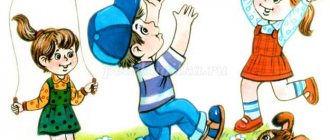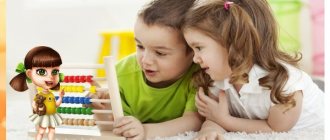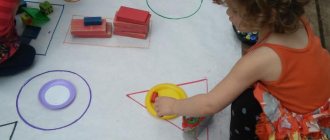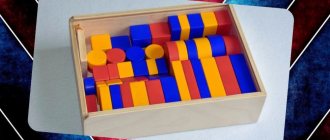The role of didactic games in FEMP classes in kindergarten
The age of 5-6 years is the most important time in a child’s life. At this time, fantasy and logic are formed, the arbitrariness of mental processes and self-esteem are formed. Children always want to know - why, how, why?
Lesson with numbers
At the preschool educational institution, the preparatory process for an educational institution begins, and cognitive activity develops. This is precisely the goal pursued by FEMP pedagogy. Children must not only be able to count to 10 back and forth, but also analyze information data, conduct analysis, classify different phenomena, find common patterns, be smart, and be able to explain and prove a personal point of view.
What to do if your child has poor memory
Types of Math Activities for Kindergarteners
Didactic mathematical games are divided into certain groups according to their content. Type of DI:
- with figures and numbers;
- time travel;
- orientation in space;
- with geometric shapes;
- to logic.
Thanks to different types of games, students are taught to count forward and backward, and to use actions according to the rules of numerals, both quantitative and ordinal.
Target.Develop logical thinking, consolidate quantitative and ordinal counting within 5. Strengthen knowledge of numbers within 5. Develop the ability to change your role behavior in accordance with the different roles of partners; ability to change playing role. Expand children's knowledge about the work of cafe workers. Foster friendships between children.
Progress of the game
— Children, have you ever been to a cafe? Did you like it there? Let's open a cafe in our group and then play it.
- Guys, let's decide together what we need for our cafe? (tables, chairs, food) Remember, we have already talked about how to arrange furniture in a cafe so that it is comfortable for all visitors. And today we will equip the cafe according to this plan. (The teacher leads the children to the place where the tables are)
- Look at the shape of the lids on our tables? (round, square). Let us arrange them as indicated in our plan.
- Which figure was drawn first? (circle)
— What shape should the top of the first table be? (round)
- Boys, put the table with the round top first.
-What figure is drawn second? (square)
— What shape will the lid of the second table have? (square). Place a table with a square top. What shape will the third table have? (round). Place a third table with a round lid.
- Look, guys, there is no fourth figure on the plan, instead there is a question. Think and tell me what the shape of the fourth table cover should be? (children's answers)
— To make our cafe beautiful, let’s cover each table with a tablecloth. Look, what color tablecloths do we have? (red and yellow). To find out how to do it right
spread out the tablecloths, you and I need to look at this card.
— What color is the first figure on the card? (red). This means that we will cover the first table with a red tablecloth. What color tablecloth will we set the second table with? And the third?
— What color tablecloth do you think the fourth table should be set with? (children's answers)
— Guys, in cafes, waiters deliver orders to visitors, so that it is convenient for them to work, there are numbers on each table. Let's put numbers on our tables too. (Children and their teacher arrange the numbers.)
— We have arranged the tables, think about what else we need to do? (Arrange the chairs)
- Children, here are the chairs, each of them has a number on it. Place chairs at tables.
- Guys, we have arranged the tables and chairs for you. What do we need to open our cafe? (Food). That's right, to cook food we need food. Where do you think we can get them? (in the shop). We will send Anton and Egor for groceries; they will be our drivers. And I will be the seller. Here are cards for you boys, they indicate how much and what products you will have to purchase and bring by car.
- And you girls will be waitresses and set the tables. Place cups and saucers on each table and don't forget to decorate the table with flowers. (The girls set the tables, the boys “purchase” the food.)
- And now I will be the director of the cafe and I want to check whether the drivers brought us all the necessary products (check).
“And now I’ll check the work of our waiters, whether they set the tables correctly.” So, I am satisfied with the work of both the drivers and the waiters. Our cafe is ready to welcome visitors.
- Girls, you can take your girlfriends and daughters and bring them to our cafe.
Methodology for conducting classes on FEMP in kindergarten
As a training base for those preparing to go to first grade, special methods are used:
- subsequence;
- consistency;
- individuality;
- logic.
The knowledge that the teacher imparts to children becomes more and more complex from lesson to lesson, taking into account the level of development of the students. For repetition, special role-playing games are used. Mathematics becomes the pupils’ favorite subject; they study with pleasure, look for similarities and differences in subjects, and focus on subtleties in order to answer the teacher’s question.
Game with the teacher
Recommendations for organizing classes
It is important to organize the game positively and competently. Kindergarten age does not provide for the use of unsatisfactory grades or reprimands from the teacher. You cannot compare one child with another; only an analysis of the student’s personal growth is allowed.
The teacher must use in his work those methods and techniques that provoke interest. “Forced” classes are useless and create aversion to mathematics and algebra.
For your information. If there is personal contact and a positive relationship between the student and his mentor, there will be a successful outcome.
An example of a calendar-thematic lesson plan for FEMP
In the morning, the teacher talks about the heroes of the fairy tale “Turnip”. Together, participants look at pictures of characters. Next, during the walk, the participants play the game “Line up like a turnip in a fairy tale,” and at lunchtime the teacher tells the fairy tale “Turnip.” In the evening, the fairy tale is played out, and unconventional drawing of geometric shapes takes place. During the second walk, the children and the teacher play “Edible-Inedible” (with a ball) and put together the “Turnip” puzzle. They create costumes for the fairy tale “Turnip”.
The Federal State Educational Standard for kindergartens contains a list of concepts that should be developed by graduates of preschool educational institutions.





